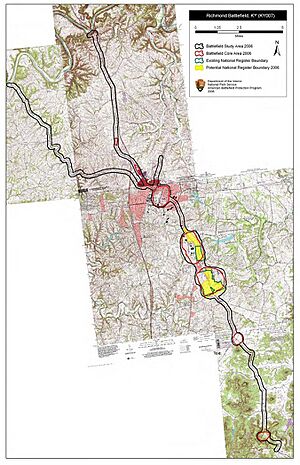Battle of Richmond facts for kids
Quick facts for kids Battle of Richmond |
|||||||
|---|---|---|---|---|---|---|---|
| Part of the American Civil War | |||||||
|
|||||||
| Belligerents | |||||||
| Commanders and leaders | |||||||
| William "Bull" Nelson (WIA) | Edmund Kirby Smith | ||||||
| Units involved | |||||||
| Army of Kentucky (Union) | Army of Kentucky (Confederate) | ||||||
| Strength | |||||||
| 6,850 | 6,500 | ||||||
| Casualties and losses | |||||||
| 5,353 total (206 killed 844 wounded 4,303 captured/missing) |
451 total (78 killed 372 wounded 1 missing) |
||||||
The Battle of Richmond was a major fight during the American Civil War in Richmond, Kentucky. It happened on August 29–30, 1862. The Confederate army, led by General Edmund Kirby Smith, won a huge victory. They defeated the Union army, led by General William "Bull" Nelson. This battle was the first big event in the Confederates' plan to take over Kentucky.
Contents
Why the Battle Happened
In the fall of 1862, two Confederate armies moved into Kentucky. Their goal was to bring the Confederate government back to power in the state. They also wanted to threaten Union cities along the Ohio River. Another important goal was to get more men to join their army.
General Kirby Smith led the first Confederate army. He started his march from Knoxville on August 13. General Braxton Bragg led another Confederate army. He moved on a path to the west, starting from Chattanooga on August 27.
The Battle Begins
Confederate General Patrick Cleburne led the first group of soldiers. His cavalry (soldiers on horseback) rode ahead. On August 29, 1862, these cavalry soldiers met Union troopers. They started a small fight, called a skirmish.
Later that day, Union artillery (big guns) and infantry (foot soldiers) joined the fight. They forced the Confederate cavalry to fall back. Union General Mahlon Dickerson Manson was in charge of the Union forces there. He sent more soldiers to face the Confederates. The fighting stopped for the day after a brief clash. That night, General Manson told his commander, General Nelson, about the situation. Nelson ordered more troops to be ready to help.
Main Attack and Union Retreat
Kirby Smith told General Cleburne to attack early the next morning. He also promised to send more soldiers to help. Cleburne started marching north very early. He went through Kingston and pushed back Union scouts. Then, he reached General Manson's battle line near Zion Church.
As the day went on, more soldiers joined both sides. First, there was an artillery duel, where both sides fired their big guns. Then, the Confederates launched a strong attack on the Union's right side. The Union soldiers could not hold their ground and had to retreat. They tried to make another stand in Rogersville, but it did not work.
By this time, both General Smith and General Nelson had arrived. They took command of their armies. Nelson tried to gather some of his troops in a cemetery outside Richmond. But these soldiers were also quickly defeated.
After the Battle
General Nelson and some of his men managed to escape. However, the Confederates captured over 4,300 Union soldiers. The Union army suffered heavy losses. In total, 5,353 Union soldiers were killed, wounded, or captured. The Confederates had far fewer losses, with 451 soldiers killed, wounded, or missing.
After this big victory, the path north was open for the Confederates. They could now move towards Lexington and Frankfort.
See also
 In Spanish: Batalla de Richmond (1862) para niños
In Spanish: Batalla de Richmond (1862) para niños


